Rajasthan Board RBSE Class 12 Biology Chapter 11 Respiration
RBSE Class 12 Biology Chapter 11 Multiple Choice Questions
Question 1.
What is the site of the Krebs cycle in cells?
(a) Nucleus
(b) Cytoplasm
(c) Plastids
(d) Mitochondria
Answer:
(d) Mitochondria
Question 2.
How many ATP are formed as a net gain in anaerobic respiration?
(a) Three
(b) Four
(c) Eight
(d) Two
Answer:
(d) Two
![]()
Question 3.
During protoplasmic respiration, what acts as a respiratory substrate?
(a) Fats
(b) Proteins
(c) Sugar
(d) All the above
Answer:
(b) Proteins
Question 4.
What is called the universal energy coin of the cell?
(a) ATP
(b) DNA
(c) RNA
(d) AMP
Answer:
(a) ATP
Question 5.
The net gain of energy in glycolysis is –
(a) 12 ATP
(b) 2 ATP
(c) 4 ATP
(d) Zero ATP
Answer:
(b) 2 ATP
Question 6.
Where is pyruvic acid converted into acetyl CoA?
(a) In cytoplasm
(b) In a matrix of mitochondria
(c) On the outer membrane of mitochondria
(d) On cristae
Answer:
(b) In a matrix of mitochondria
![]()
Question 7.
How many ATP are formed when 2 molecules of NADH + H+ formed in glycolysis enter ETS via malate aspartate shuttle?
(a) Two
(b) Four
(c) Six
(d) Eight
Answer:
(c) Six
Question 8.
How many ATP are formed in the oxidation of one molecule of glucose through the pentose phosphate path?
(a) 36
(b) 38
(c) 40
(d) 8
Answer:
(a) 36
Question 9.
Who proposed the chemiosmotic theory of oxidative phosphorylation?
(a) Krebs
(b) Gibbs
(c) Mitchell
(d) Dixons
Answer:
(c) Mitchell
Question 10.
During the Krebs cycle, the first and the only five carbon-containing compounds formed is?
(a) Cis-aconitic acid
(b) Oxaloacetic acid
(c) α-ketoglutaric acid
(d) Fumaric acid
Answer:
(c) α-ketoglutaric acid
![]()
Question 11.
The value of R.Q. is less than one of which substrate?
(a) Glucose
(b) Sucrose
(c) Starch
(d) Proteins
Answer:
(d) Proteins
Question 12.
The value of Q10 of respiration is –
(a) Three
(b) Two
(c) Four
(d) Six
Answer:
(b) Two
Question 13.
The site of reactions of the pentose phosphate path in cells is –
(a) Mitochondria
(b) Peroxisomes
(c) Cytoplasm
(d) Nucleus
Answer:
(c) Cytoplasm
RBSE Class 12 Biology Chapter 11 Very Short Answer Questions
Question 1.
What is the end product of glycolysis?
Answer:
Pyruvic acid (CH3CO.COOH)
Question 2.
Where the reactions of aerobic respiration are completed in the cell?
Answer:
Mitochondria
Question 3.
Why the Krebs cycle is also called the TCA cycle?
Answer:
Krebs cycle reactions begin with the formation of citric acid which contains three (COOH) carboxylic groups. Hence it is called T.C.A. cycle.
Question 4.
Name the alternative path of oxidation of glucose.
Answer:
Pentose phosphate path (PPP) or Hexose monophosphate path (HMP)
![]()
Question 5.
What do you understand by protoplasmic respiration?
Answer:
When proteins are used as respiratory substrate the process is called protoplasmic respiration.
Question 6.
What is meant by fermentation?
Answer:
Anaerobic respiration taking place in bacteria and fungi, in which glucose is oxidized into alcohol and CO2 or some organic acid, is called fermentation.
Question 7.
What is meant by respiratory substrates?
Answer:
High energy-containing complex organic compounds oxidized during respiration are called respiratory substrates.
Example: Carbohydrates, fats proteins etc.
Question 8.
Write the name of end products formed by complete oxidation of glucose.
Answer:
CO2H2O and energy (ATP).
Question 9.
Define respiratory quotient?
Answer:
The respiratory quotient is the ratio of the volume of CO2 released to the volume of O2 used in respiration. It can be represented as

Question 10.
Why the value of R.Q. is infinite (∝) in anaerobic respiration?
Answer:
During anaerobic respiration, the substrate is oxidized without the use of O2. As CO2 is given out and O2 is not used, hence the value of R.Q. is infinite.
Question 11.
Which substance is called connecting link between glycolysis and Krebs cycle?
Answer:
Acetyl coenzyme A is called as a connecting link between glycolysis and Krebs cycle.
Question 12.
What is the value of R.Q. of germinating seeds of castor?
Answer:
The respiratory substrate in the germinating seeds of castor is fat and its R.Q. is 0.7.
Question 13.
Name the scientist who proposed the chemiosmotic theory.
Answer:
Peter Mitchell proposed the chemiosmotic theory.
Question 14.
What are the products formed during fermentation?
Answer:
Ethyl alcohol and CO2 or Lactic acid, Acetic acid, Butyric acid etc.
RBSE Class 12 Biology Chapter 11 Short Answer Type Questions
Question 1.
What is the difference between free-floating respiration and protoplasmic respiration?
Answer:
In free-floating respiration, carbohydrates are used as a respiratory substrate whereas in protoplasmic respiration proteins are used as a respiratory substrate. Free-floating respiration is the normal respiration process of an organism and protoplasmic respiration takes place when all carbohydrates and fats are used up and when the organisation is under starvation condition.
![]()
Question 2.
Explain the difference between aerobic and anaerobic respiration.
Answer:
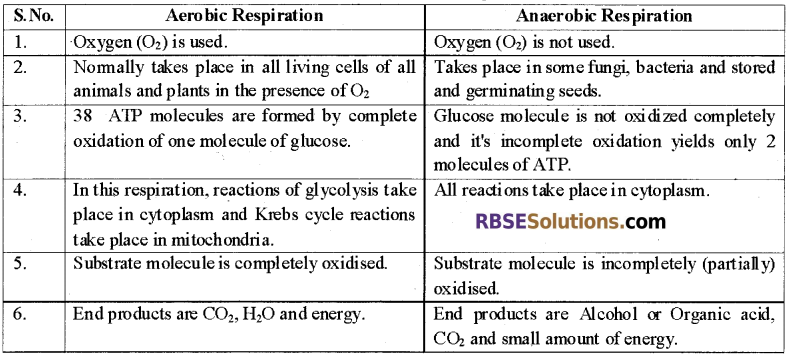
Question 3.
“Fruits and vegetables remain safe for long duration in cold storage”. why?
Answer:
Fruits and vegetables are stored in cold storage at very low, temperature. At this low temperature, the rate of respiration is very low and microbial activity is extremely low. Hence the fruits and vegetables escape spoilage and remain fresh and safe for a long duration.
Question 4.
Write a note on pentose phosphate path (PPP).
Answer:
Pentose phosphate path is an alternative path for complete oxidation of glucose. In this process hexose sugar is oxidized through the involvement of a five carbon-containing sugar, hence it is called a pentose phosphate path.
Racker and coworkers (1954) studied details of pentose phosphate path. The reactions of PPP take place in the presence of oxygen. This process is completed in the cytoplasm of the cell.
The main steps of PPP are as follows:
- Phosphorylation of glucose.
- Oxidation of glucose 6-phosphate.
- Oxidative decarboxylation of phosphoglucose acid and formation of ribulose-5 phosphate.
- A complete break down of ribulose – 5 phosphates through several reactions.
Question 5.
Draw outline diagram showing the interrelationship between respiratory substrates.
Answer:
Outline diagram of inter-relationship.
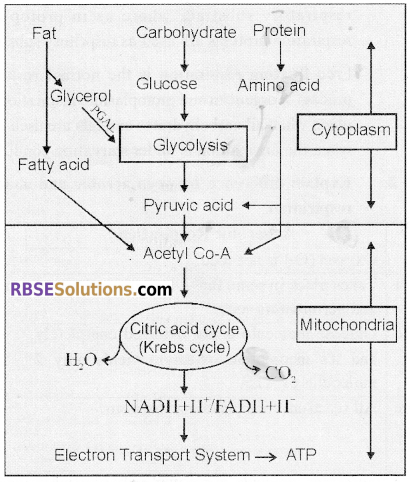
Question 6.
Write short notes on the following
- Fermentation.
- Oxidative break down of pyruvic acid.
- Respiratory Quotient.
- Chemiosmotic theory of Peter Mitchell.
Answer:
1. Fermentation:
Anaerobic respiration taking place in bacteria and fungi, in which glucose is incompletely oxidized into alcohol and CO2 or organic acid is called fermentation.
![]()
2. Oxidative break-down of pyruvic acid:
Pyruvic acid formed as an end product of glycolysis enters mitochondria and in the matrix region of mitochondria, it is completely oxidized into CO2 and H2O in the presence of oxygen.
This is called an oxidative breakdown of pyruvic acid. Before entry into mitochondria, pyruvic acid is converted into Acetyl Coenzyme-A by decarboxylation and dehydrogenase enzyme. This complex reaction is catalyzed by five co-factors.
These are Coenzyme A; NAD+; Mg++; Thymine pyrophosphate (TPP) and Lipoic acid.
Acetyl Coenzyme – A formed in this reaction acts as a connecting link between glycolysis and Krebs cycle.
3. Respiratory Quotient:
The ratio of the volume of CO2 released in respiration to the volume of O2 used is called respiratory quotient. The value of R.Q. of different respiratory substrates is as follows:
R.Q. of carbohydrate = 1.0
R.Q. of fats = 0.7
R.Q. of proteins = 0.8
R.Q. of organic acids = 1.33
R.Q. of succulents = zero
Anaerobic respiration R.Q. = infinite (∝).
4. Chemiosmotic theory of Mitchell:
This theory was proposed by Mitchell to explain ATP formation during respiration and photosynthetic process. According to this theory, transport of positively charged protons (Hydrogen ions) across the membrane of mitochondria or chloroplasts takes place through the enzymes involved in these processes via an electron transport system. Due to this, the electrochemical gradient is created on two sides of the membrane.
![]()
Question 7.
How the value of R.Q. is affected by the nature of respiratory substrates?
Answer:
The value of R.Q. depends upon the nature of the respiratory substrates. The value of R.Q. is variable according to the substrate. The substrates having more oxygen in comparison to carbon, need less oxygen for oxidation and hence their R.Q. is more than 1, whereas those substrates where O2 is less than carbon, require more O2 for their oxidation and their R.Q. is less than one.
R.Q. of carbohydrates = 1.0
R.Q. of fats = 0.7 (<1)
R.Q. of proteins = 0.8 (<1)
R.Q. organic acids = 1.33 (>1)
RBSE Class 12 Biology Chapter 11 Essay Type Questions
Question 1.
What do you understand by glycolysis? Explain in details various reactions of this process and their energy relation.
Answer:
The process of breakdown of one molecule of glucose into two molecules of pyruvic acid through a series of biochemical reactions is called glycolysis. The whole process can be expressed by the following equation.
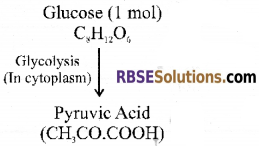
- The term Glycolysis has originated from Greek work “Glycose”, (meaning sugar) and Lysis (meaning break down, dissolve, analysis), and means the breakdown of sugar. This is a complex biochemical process and is completed in ten steps.
- Different steps of Glycolysis were worked out by G Embden, Otto Meyerhoff, and J.Parnas in 1930, hence this process is also called EMP path. This is completed in the cytoplasm of the cell and O2 is not used in the process.
- Glycolysis takes place by the same reactions in all types of organisms and is found in both aerobic and anaerobic respiration.
- It can be defined as, “Breakdown of a glucose molecule into pyruvic acid through a series of biochemical reactions along with the release of energy is called glycolysis”.
- All the 10 biochemical reactions occurring during glycolysis can be studied under three heads.
- Phosphorylation of Glucose
- Splitting of phosphorylated hexose molecule in two molecules of phosphoglyceraldehyde
- Formation of two molecules of pyruvic acid.
1. Phosphorylation of Glucose:
- In the first step of glycolysis one molecule of glucose changes in glucose-6-phosphate by use of one ATP molecule in the presence of hexokinase enzyme.
- In the presence of isomerase enzyme, Glucose-6-phosphate changes into fructose-6-phosphate.
- Fructose-6-phosphate using one molecule of ATP further changes into fructose 1-6-diphosphate in the presence of enzyme phosphofructokinase.
- The reactions taking place during the phosphorylation of glucose are as follows:
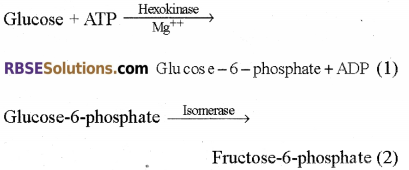

2. Splitting of Phosphorylated Hexose molecule in two molecules of Phosphoglyceraldehyde:
- In this reaction, fructose 1-6-diphosphate breaks down in one molecule of phosphoglyceraldehyde (3-PGAL) and one molecule of dihydroxyacetone phosphate (DHAP) in the presence of aldolase enzyme.
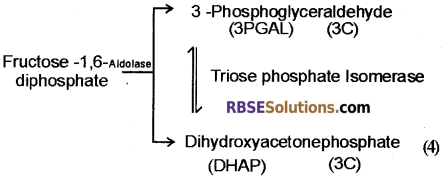
- These two compounds are interconvertible in the presence of triphosphate isomerase enzyme.
- Of these compounds, oxidation takes place of only 3-PGAL. Hence as 3-PGAL is oxidised, DHAP keeps on changing to 3-PGAL.
![]()
3. Formation of two molecules of Pyruvic Acid:
3-phosphoglyceraldehyde (3PGAL) molecules are oxidized and converted into two molecules of pyruvic acid by the following reactions.
- Formation of 1-3 di-phosphoglyceric acid:
3-PGAL molecule reacts with H3PO4 in the presence of enzyme dehydrogenase and forms 1-3 di-phosphoglyceraldehyde. This is oxidized to form 1-3 di-phosphoglyceric acid. This is called oxidative step. Hydrogen ions released in this reaction reduce NAD+ to NADH + H+ which generates ATP through electron transport chain in case of aerobic respiration.


- Formation of 3-phosphoglyceric acid from 1-3 di-phosphoglyceric acid:
In this reaction, one phosphate group is removed from 1-3 di-phosphoglyceric acid in the presence of enzyme di-phosphoglycerokinase. ADP is converted in ATP and 3-phosphoglyceric acid is formed.

- The isomerisation of 3-phosphoglyceric acid into 2-phosphoglyceric acid: 3-phosophoglyceric acid is changed to its isomeric form 2-phosphoglyceric acid in the presence of enzyme phosphoglyceromutase.

- Formation of 2-phosphoenolpyruvate from 2phosphoglyceric acid: 2-phosphoglyceric acid changes to 2-phosphoenolpyruvate by losing one molecule of water in the presence of enzyme enolase.

- Formation of Pyruvic acid from 2-phosphoenolpyruvate:
In the presence of enzyme pyruvic kinase, 2-phosphoenolpyruvate loses one phosphate and forms pyruvic acid and ATP molecule.

- The process of Glycolysis can be explained in totality by the following reaction.

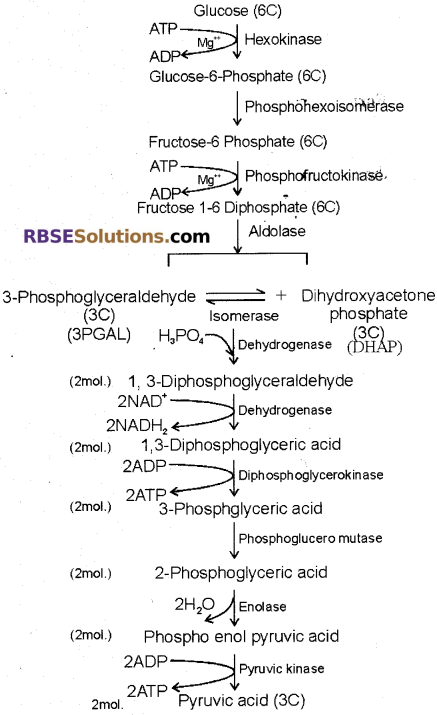
Question 2.
Define respiration and differentiate between aerobic and anaerobic respiration.
Answer:
The metabolic activity occurring in the living cells of all organisms in which complex organic compounds are broken down into simpler compounds with release of energy is called respiration. The process in which carbohydrates are completely oxidized into CO2 and H2O and energy are released in the form of ATP molecules, is called aerobic respiration. The process in which carbohydrates are incompletely oxidized without using into ethyl alcohol and CO2 is called anaerobic respiration.
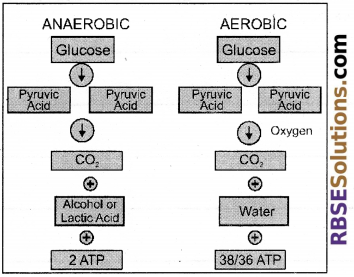
![]()
Question 3.
What do you understand by oxidative phosphorylation? Describe the electron transport system in detail.
Answer:
Conversion of ADP and Pi into ATP by use of energy released in the oxidation-reduction process in the presence of O2 is called oxidative phosphorylation. During respiration oxidative phosphorylation occurs in the F1 particles on the inner membrane of mitochondria.
Electron transport system (ETS)
The NADH + H+ and FADH + H+ formed during glycolysis and Krebs cycle reactions are oxidized through a series of reactions and ATP are formed during this process.
In this phase of aerobic respiration, electrons flow from one acceptor to another in a definite sequence and finally O2 acts as a terminal acceptor of electrons. This flow of electrons in a series is called electron transport system.
All enzymes participating in these reactions are found in the F1 particle located on the inner membrane of mitochondria.
Electron Transport System:
- For continuity of reactions of glycolysis and Krebs cycle, it is necessary that NADH + H+ and FADH2 formed during these reactions are oxidized back to NAD+ and FAD+.
- This oxidation occurs in mitochondria through electron transport system and energy is released in the form of ATP.
- During electron transport system electrons flow from one electron acceptor to another in a definite sequence.
- The electrons jump from high energy level acceptor to the low energy level acceptor releasing energy at some steps which are used in ATP synthesis.
- All enzymes participating in these reactions are found in the inner membrane of mitochondria.
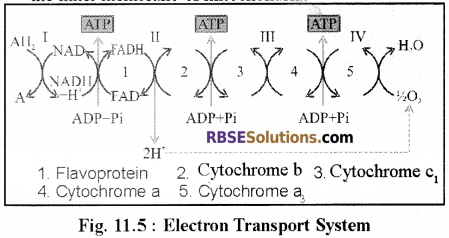
- The components of the electron transport system (ETS) or electron carriers have been sequenced as follows, which are called complexes.
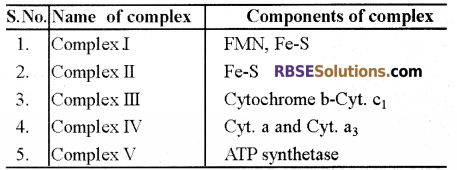
- In addition to these, two-electron carriers cytochrome c and coenzyme Q (Ubiquinone) is also included in the sequence.
- NADH + H+ and FADH2 are oxidized and the electrons are transported in a definite sequence through ETS.
![]()
This can be explained as follows:
- NADH + H+ formed in the matrix of mitochondria during the Krebs cycle is oxidized to NAD+ by dehydrogenase enzyme.
- The electrons released in this reaction are accepted by components of complex I found on the inner membrane. This multiprotein complex mainly includes NADH, ubiquinone oxide-reductase, and flavin mononucleotide (FMN).
- The components of complex II receive electrons released in the oxidation of succinic acid in the presence of succinate ubiquinone oxidoreductase enzyme. The reducing equivalents are transferred through FADH2.
- Electrons from the reduced ubiquinone are transported to the components of complex III i.e. cytochrome b and cyt.c1.
- The cytochrome ci is a small protein loosely attached to the surface of the inner membrane of mitochondria.
- It serves as a mobile carrier and transports electrons from complex III to Complex IV.
- Cytochrome c-oxidase complex (Cyt. a Cyt a3 etc.) constitutes the last carrier in the chain of electron transport.
- It is referred to as terminal oxidase of the cytochrome chain.
- The reduced cytochrome a3 has the ability to transfer electrons to O2 and reducing it to H2O.
- In essence, the ETS is a chain of carriers where electrons transported from complex I to complex (IV) flow from a higher to a lower level of energy. During this, the ATP synthetase complex converts ADP and inorganic phosphate into ATP.
- The number of ATP molecules formed during this process depends on the nature of the electron donor.
- One molecule of NADH + H+ generates 3 ATP whereas one molecule of FADH2 generates the only 2ATP.
- Oxygen (O2) acts as the terminal acceptor of electrons in this process.
- As in this process phosphorylation takes place in the presence of oxygen by its utilization in oxidation, it is called oxidative phosphorylation.
Question 4.
Write a brief account of the factors affecting respiration.
Answer:
Factors affecting respiration are divided into two categories.
- External or environmental factors
- Internal or plant factors.
1. External factors
- Temperature
- Oxygen
- Water
- Light
- Carbon dioxide
2. Internal factors
- Protoplasm
- Respiratory substrate
- Age of Cell
- Wound and injury
![]()
1. External factors or Environmental Factors:
1. Temperature:
It is the most important factor affecting the rate of respiration. Normally the rate of respiration increases to a certain limit by an increase in temperature from 5.0°C to 30.0°C. In this range, the rate of respiration increases as per Vont Hoff’s rule. According to this a rise in temperature by 10°C, the rate of respiration becomes double.
Increase in temperature beyond 35.0°C results into decrease in rate as the enzymes begin to denaturalize. At very low temperatures also enzymes become inactive and the rate of respiration decreases. In cold storage, the fruits and vegetables escape spoilage because of this.
2. Oxygen:
Oxygen is necessary for aerobic respiration because it acts as a terminal acceptor of electrons. At low concentration of oxygen both aerobic and anaerobic respiration may take place, but when the concentration of oxygen becomes zero only anaerobic respiration takes place. Under such a condition value of R.Q. becomes infinite (∞).
3.Water:
Water acts as a medium for all the metabolic activities. The protoplasm contains up to 90-95% of water. Water plays an important role in enzyme activation, gaseous diffusion, transportation etc.
In dry seeds and fruits rate of respiration is extremely low due to the shortage of water and so these can be stored for a long duration. In the presence of water stored carbohydrates convert into soluble sugar and the rate of respiration increases.
4. Light:
Rate of respiration is not influenced directly by light and so it takes place in the presence as well as an absence of light. However light as a factor may influence the rate of respiration as follows:
- Light causes an increase in temperature which may cause an increase in the rate of respiration.
- Photosynthesis results in the synthesis of sugar which acts as a respiratory substrate.
- In the presence of light stomata open and so, the gaseous exchange is facilitated.
5. Carbon dioxide (CO2):
Increase in concentration of CO2 inhibits respiration. Hence it has an adverse effect on the germination of seeds and rate of growth of plants. Heath experimentally proved that an increase in the concentration of CO2 causes the closure of stomata and the rate of respiration decreases due to a shortage of oxygen.
Internal factors or Plant Factors:
1. Protoplasm:
Meristematic cells have dense and active cytoplasm and so the rate of respiration is relatively high in these cells as compared to the mature cells. The activity of protoplasm is affected by several factors such as hydration, pH, temperature etc.
2. Respiratory substrate: Different types of sugars such as glucose, fructose, maltose etc. present in the cell are quickly used in respiration. In comparison to these starch and fats need to be first converted into a soluble form and only then they can be used as a respiratory substrate. This is the reason why in hospitals a patient is administered directly with, glucose, whereas the normal diet of healthy persons contains starch and fats.
3. Age of Cells:
Rate of respiration is much higher in the young cells as compared to mature and old cells.
4. Wound and Injured part:
Rate of respiration sharply increases in the wound and injured part to promote healing.
Question 5.
What is respiratory quotient? Explain the R.Q. of different respiratory substrates.
Answer:
The ratio of the volume of CO2 released to the volume of O2 used in respiration is called respiratory quotient.
During the process of respiration different organic compounds are oxidized and normally oxygen is used and carbon dioxide is released. The ratio of the volume of CO2 released to the volume of O2 used in respiration is called respiratory quotient (R.Q.) it is measured with the help of Ganong’s respirometer.

The value of R.Q. is helpful in determining the type of substrate used and the type of respiration. The value of R.Q. varies with the type of substrate used in respiration. This can be explained by the following:
1. R.Q. of carbohydrates:
When carbohydrate is a respiratory substrate and it is completely oxidized, its R.Q. is always unit or 1 (one). In this process, the volume of CO2 released is always equal to the volume of O2 used.

2. R.Q. of fats:
In oilseeds (Mustard, Groundnut, Cotton seeds etc.) fats are used as a respiratory substrate during germination. In fat molecules, the amount of O2 is less in comparison to carbohydrates. Hence fats require more oxygen for their oxidation and so the value of R.Q. of fats is always less than one.

3. R.Q. of proteins:
Protein molecules also have an amount of O2 less in comparison to the amount of carbon like fats. Hence oxidation of proteins also requires more O2 and hence the value of R.Q. of proteins is also less than one (<1), (0.7 -0.9). Proteins act as a respiratory substrate in the absence of carbohydrates and fats.
Example: In Human proteins are used as respiratory substrate after prolonged fasting and its continuance is indicative of the death of Human.
![]()
4. R.Q. of organic acids:
In some plants, organic acids act as respiratory substrates. The molecules of organic acids have an amount of oxygen more than carbon. Hence oxidation of organic acids requires much less oxygen and release CO2 in a large amount. Hence the value of R.Q. of organic acids is always more than one (>1) (4.0)
![]()

Respiratory Quotient of citric acid and malic acid is 1.14 and 1.33 respectively.
5. R.Q. of succulent or fleshy plants:
In fleshy or succulent plants such as Opuntia etc. although carbohydrate is used as a respiratory substrate it is not completely oxidized. As a result, intermediate compounds are formed but CO2 is not released. Hence in these plants, the value of R.Q. is zero.

6. R.Q. in Anaerobic Respiration:
In anaerobic respiration, CO2 is released but O2 is not used hence in this type of respiration the value of R.Q. = ∝.

It is observed that lesser is the value of R.Q. more is the energy released in the process. Hence more energy is released from one molecule of fat whereas energy released in the oxidation of organic acid and during anaerobic respiration is much less.